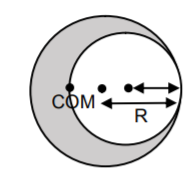A metallic sphere of diameter D has a cavity of diameter d at its centre. If the sphere is heated, the diameter of the cavity will:
Decrease
Increase
Remain unchanged
Decrease if d<D/2 and increase if d>D/2
The correct Answer is:B
To solve the problem, let's analyze the situation step by step:
Step 1: Understanding the Sphere and Cavity
We have a metallic sphere with an outer diameter D and a central cavity with a diameter d. The sphere is made of metal, which expands when heated.
Hint: Visualize the sphere and the cavity to understand how they relate to each other.
Step 2: Heating the Sphere
When the metallic sphere is heated, every part of the sphere expands uniformly. This means that the outer diameter D will increase due to thermal expansion.
Hint: Remember that thermal expansion affects all dimensions of solid objects.
Step 3: Effect on the Cavity
As the outer diameter D increases, the material of the sphere expands outward. Since the cavity is part of the sphere, the diameter of the cavity d will also increase. This is because the cavity is surrounded by the expanding material of the sphere.
Hint: Consider how the material surrounding the cavity behaves when heated.
Step 4: Conclusion
Therefore, when the sphere is heated, both the outer diameter D and the inner diameter d of the cavity will increase. The expansion occurs uniformly, affecting both the sphere and the cavity.
Hint: Think about the concept of expansion at a molecular level; all parts expand, including the cavity.
Final Answer
The diameter of the cavity will increase when the metallic sphere is heated.
We have a metallic sphere with an outer diameter D and a central cavity with a diameter d. The sphere is made of metal, which expands when heated.
When the metallic sphere is heated, every part of the sphere expands uniformly. This means that the outer diameter D will increase due to thermal expansion.
As the outer diameter D increases, the material of the sphere expands outward. Since the cavity is part of the sphere, the diameter of the cavity d will also increase. This is because the cavity is surrounded by the expanding material of the sphere.
Therefore, when the sphere is heated, both the outer diameter D and the inner diameter d of the cavity will increase. The expansion occurs uniformly, affecting both the sphere and the cavity.
The diameter of the cavity will increase when the metallic sphere is heated.
Topper's Solved these Questions
- HEAT TRANSFER BOOK - PHYSICS GALAXY - ASHISH ARORACHAPTER - HEAT TRANSFER EXERCISE - Numerical MCQs Single Options Correct
94 Videos
- HEAT TRANSFER BOOK - PHYSICS GALAXY - ASHISH ARORACHAPTER - HEAT TRANSFER EXERCISE - Advance MCQs with One or More Option Correct
20 Videos
- HEAT TRANSFER BOOK - PHYSICS GALAXY - ASHISH ARORACHAPTER - HEAT TRANSFER EXERCISE - Discussion Question
26 Videos
- HEAT AND THERMAL EXPANSIONBOOK - PHYSICS GALAXY - ASHISH ARORACHAPTER - HEAT AND THERMAL EXPANSIONEXERCISE - UNSOLVED NUMRICAL PROBLEMS FOR PREPARATION OF NSEP, INPhO & IPhO
82 Videos
- Kinetic Theory of Gases and Gas LawsBOOK - PHYSICS GALAXY - ASHISH ARORACHAPTER - Kinetic Theory of Gases and Gas LawsEXERCISE - Unsolved Numerical Problems for Preparation of NSEP, INPhO & IPhO
64 Videos
Similar Questions
Knowledge Check
A metallic ball has spherical cavity at its centre. If the ball is heated, what happens to the cavity
AIts volume decreases.BIts volume remains constant.CIts volume increases.DNothing can be decided.A uniform solid sphere of radius R has a cavity of radius 1m cut from it if centre of mass of the system lies at the periphery of the cavity then
 A(R2+R+1)(2–R)=1B(R2–R–1)(2–R)=1C(R2–R+1)(2–R)=1D(R2+R–1)(2–R)=1
A(R2+R+1)(2–R)=1B(R2–R–1)(2–R)=1C(R2–R+1)(2–R)=1D(R2+R–1)(2–R)=1A sphere is rotating about a diameter
Athe particles on the surface of the sphere do not have any linear accelerationBthe particles on the diameter mentioned above do not have any linear accelerationCdifferent particle son the surfce have different angular speeds.DAll particles on the surface have same linear speed
If three metallic spheres of radii 6 cm, 8 cm and 10 cm are melted to form a single sphere, then the diameter of the new sphere will be (a) 12 cm (b) 24 cm (c) 30 cm (d) 36 cm
View SolutionThree solid metallic spheres of diameters 6 cm, 8 cm and 10 cm are melted and recast into a new solid sphere. The diameter of the new sphere is :
View SolutionThousand solid metallic spheres of diameter 6 cm each are melted and recast into a new solid sphere. The diameter of the new sphere (in cm) is
View SolutionChoose the most appropriate option.
A metallic ball has spherical cavity at its centre. If the ball is heated, what happens to the cavity?
View SolutionA sphere (μ=43) of radius 1m has a small cavity of diameter 1cm at its centre. An observer who is looking at it from tight, sees the magnification of diameter of the cavity as
View Solution
